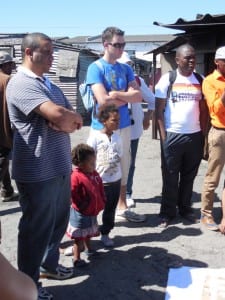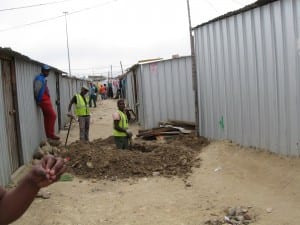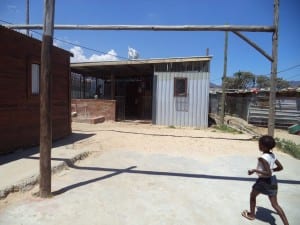Scene 1: And So It Begins… Touring Informal Settlements
Setting: CORC Office, Flamingo Crescent Informal Settlement, Mtshini Wam Informal Settlement, Langrug Informal Settlement
Backstory:
Our project will be primarily focused in the settlement of Langrug, where in 2012 WPI students worked with CORC (Community Organisation Resource Centre) and the community to construct a water, sanitation, and hygiene (WaSH) facility. There had been some uncertainty whether the project centre would be able to return to the Municipality of Stellenbosch due to political tensions among municipal leaders. However after meeting with the sponsors at CORC, our advisors determined that we could proceed with our plans to assess the water and sanitation facilities in Langrug. CORC recently signed a partnership with Habitat for Humanity South Africa, which does not have extensive experience working on reblocking in informal settlements. On our first day at the project centre, our liaisons at CORC were planning to show their new partners around three informal settlements where CORC has been working on reblocking. Since Langrug was one of those settlements, we accompanied the Habitat for Humanity representatives on this tour as an introduction to our project.
Cast of Characters:
We met a lot of different people in our first day of work. When we arrived to the CORC office and we met the CORC leaders as well as the Habitat for Humanity representatives. At Langrug, we met community leaders and the facility caretakers with whom we will be working for the next seven weeks.
Adi Kumar – Adi is a Regional Technical Coordinator at SDI. He planned the informal settlements visit for Habitat for Humanity.
Sizwe MXobo – Sizwe is a CORC representative. During our tour, he spoke a lot about the reblocking process in Flamingo Crescent. He also translated for the community leader in Mshini Wam.
Baraka Mwau – Baraka is a CORC representative. Baraka will be the main CORC member to guide us in our project.
Habitat for Humanity – Habitat for Humanity in South Africa develops communities in need by building and upgrading homes. There were about fifteen Habitat for Humanity representatives. In conjunction with CORC, Habitat for Humanity toured three informal settlements to gain a clear perspective of the living conditions, community dynamics, and reblocking process.
Trevor Masiy – Trevor is the elected community leader in Langrug. His priority is the community’s needs and interests. He works with CORC, the municipality, and WPI to represent the voice of Langrug.
Alfred – Alfred is also a community leader in Langrug who works with Trevor.
Caretakers – There are 3 caretakers: Victoria, Nomthandazo, and Poto. They have kept record of the facility’s use, including dates, type of usage, and the residential location of the users. A woman named Khungeka has also started acting as the mailwoman; she holds an organized mailing system in the facility.
WPI – 4 students: Ivette, Joe, Morgan, and Mackenzie.
Setting:
The three informal settlements we toured were Flamingo Crescent, Mtshini Wam, and Langrug. Flamingo contains roughly 100 shacks, which will be upgraded and reblocked starting in mid – November of 2013. Mtshini Wam was once a dense informal settlement of 250 families, but has been restructured into blocks of more formal, organised homes. Construction on these improved shacks is in its final stages, and all that remains to be completed is the placement of pipes to deliver clean water and flush toilets to every home. This infrastructure will replace the 16 public chemical toilets that currently service the entire community.
Langrug is the second largest informal settlement of Stellenbosch. Teams from WPI have been working in Langrug since 2011. In 2012, the WaSH project team began construction on a water and sanitation facility. It has been operational since the community completed construction in early 2013. It was the hope of the 2012 WaSH project team that this facility would serve as a community centre for Langrug. We were told that the facility has been used as a mini-post office for the community.
Scene:
1) CORC Office
We arrive around 8:30 after a fifteen minute cab ride from the lodge. We are all anxious to begin our day and wait what the day may hold. We meet Adi Kumar, who has worked with past WPI students and projects. He takes us to a conference room where we wait for the Habitat for Humanity people who are accompanying us on our tour for today. Baraka and Sizwe come and introduce themselves; we welcome the opportunity to put faces to the voices from the early morning Skype call during our preparation term. When Habitat for Humanity arrives there is a round of introductions. The Habitat people present include the director for all of South Africa and their director of fundraising. The Habitat for Humanity people seem to be confused as to why there are four university students joining their tour of informal settlements. We are on our way by 9:30 am.
2) Flamingo Crescent Informal Settlement
Our first stop on today’s tour. The settlement is nestled in amongst the warehouses in an industrial area of Cape Town. Two women of the community greet us: Auntie Maurie and another community leader. We gather in a rare open space, forming a circle. We can see several young children playing in the nearby street, some with shoes and some without. Auntie Maurie introduces Flamingo Crescent. The community is eight years old; they were supposedly relocated to that space by the city of Cape Town. Previously located under bridges, they believed they were only supposed to be in Flamingo Crescent for three months before receiving formal housing. The members of CORC start explaining the reblocking process and show a map of how the settlement will look once construction is completed. Two young girls come from their games to join our circle; they are later joined by two of their friends. An individual from Habitat expresses surprise at how much space there is in the settlement, Auntie Maurie explains that rather than move new people in, whenever someone dies or leaves the settlement their shack is destroyed to make more public space. After we are finished with our discussion we walk around the settlement for a view of how the settlement is currently laid out. The shacks are close together, and everything has the same shade of grey. There is a wide “street” in an outside square around the community that we use to see what we can. People come out of their homes to watch us walk past, dogs roam by the shack walls. As our tour finishes, we express our thanks for inviting us into their community. We return to the bus to travel to the next site, in a matter of minutes we are driving past a middle class neighborhood. The juxtaposition is startling.
3) Mtshini Wam Informal Settlement
We get off the bus and walk up the hill into the settlement through the archway that proudly reads “Mtshini Wam.” We are led past a leaking water tap and chemical toilets that sting our noses, dodging the standing water that has turned the pathway to mud. We are led to a cross road which offers enough open space to meet. We circle up and are joined by a woman who is one of the community leaders that worked with CORC in the successful and nearly completed re-blocking. One of the men on the trip tells us about the work that has been done in Mtshini Wam, with the woman also offering her input. Sizwe translates from Xhosa to English, and you can hear their pride as they talk about the changes that have occurred and the changes still to come. The woman tells us that the biggest change she has felt since the re-blocking and rebuilding of homes is that she can now sleep without fear at night, with the new configuration of homes providing protection and connection among neighbors. We walk around, seeing children walking and giggling down the street arm in arm, dodging laundry drying in the breeze. We come across men installing pipes for taps and toilets that will be attached to people’s houses, the final step in upgrading. People come out of their homes to greet the members of CORC and people are laughing and making jokes as we pass. We say our goodbyes as we head back to the bus to continue on our way.
4) Langrug Informal Settlement
We all fell asleep on the long ride to Stellenbosch, but we woke up as soon as we entered the settlement. We eagerly look out the windows waiting for our first glimpse of the WaSH facility, which we had only seen in pictures. We file off the bus and into the facility for lunch and brief introductions of the community members who will be showing us around Langrug. The caretakers greet us with big smiles and calls of “Molweni!”. Baraka introduces Trevor and Alfred, the community leaders that WPI has worked with in the past, as well as the women who are caretakers of the facility and will be our contacts in the community moving forward. Trevor introduces himself to the group and welcomes us (the new WPI students) to Langrug for the first time. This seems to be the first time that Habitat for Humanity is not confused by our presence on the trip. They begin to engage with us in a bigger way, asking about the work WPI has done and what we hope to do over the next couple of months. Trevor and Alfred lead us around the community, stopping regularly to show the results of previous WPI efforts in greywater and water sanitation. Trevor and Baraka spent extra time talking to us students, talking about various improvements that they would like us to add to the community. We appreciated knowing some concrete possibilities for our work in Langrug, but were a little overwhelmed by all the suggestions that they had for us. We walked all around seeing various flush toilets in mostly poor conditions. We returned to the facility for a closing discussion and reflection. All present spoke briefly about what they had learned today. The last to go was Trevor. When he was done reflecting he asked the members from Habitat what good their visit to Langrug had given the community. They gave non-committal answers, emphasising that they were still assessing how they could best function in their partnership with CORC. Trevor then elaborated that he needed to be able to explain a direct benefit to his community that would come about by their visit and him letting them walk around. Despite the representatives’ attempts to justify Habitat for Humanity’s presence in Langrug today, Trevor did not seem satisfied by their answers.
Reflection and Learning:
Our first day on the job was a long, eye opening, and exciting experience. Although we had researched informal settlements extensively prior to arriving in Cape Town, seeing them in person gave us an entirely different perspective. Watching people move through their daily lives, looking at the water and sanitation facilities, and seeing the greywater flowing through these settlements made us feel the true importance of our project, and made us think about how to best focus our efforts to benefit the community. Seeing different communities in their various states of reblocking also gave us an idea of the effects of upgrading on a community’s morale. While the atmosphere and community interactions in Flamingo Crescent were dark and cheerless, the communities in Mtshini Wam and Langrug seemed to be more lively and thriving. While all of these communities have a lot of room for infrastructural improvements and upgrades, they are not without hope. Throughout each of the communities, from underdeveloped Flamingo Crescent to reblocked Mshini Wam to WaSH upgraded Langrug, there are beacons of hope. There are families with mothers and fathers who will do anything to make the homes and lives of their children better. There are community leaders who will stand up to fight for the housing and service needs of their neighbors. We are working with passionate people who will want to see a direct benefit from our work in the Cape Town area. We can only hope that we will share their passion as we work collaboratively to upgrade the community, and that our work will leave a lasting, positive impact on all of our lives.






